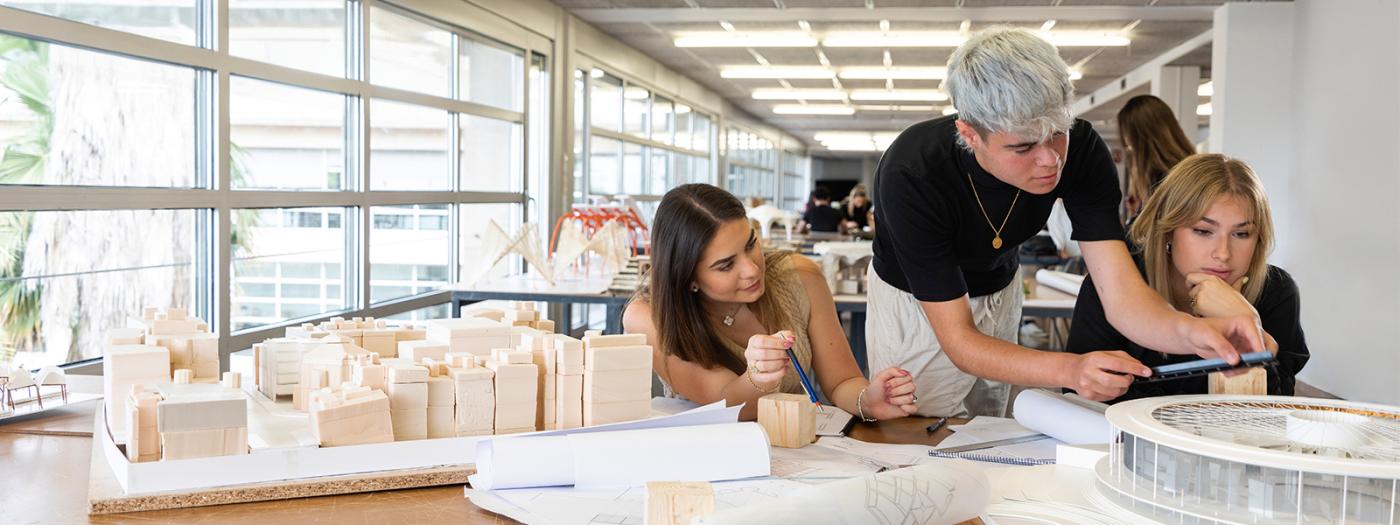Titular Professors
Professors
Knowledge of the previous studies.
3. Competences that the subject helps to develop:
3.1 General competences:
3.1.1 Instrumental competences:
IS1 Analysis and synthesis capacity
3.1.2 Interpersonal competences
IT2 Work in teams
IT9 Be sensitive with the environment
3.1.3 Systematical competences
CS1 Capacity to apply knowledge into practice
3.2 Specific competences:
3.2.1 Architecture
3.2.1.1.A. Abilities none
3.2.1.2.B. Knowledge
B 14 Ecology and sustainability
B25 Building materials
B26 Conventional building systems
B27 Industrialized building systems
3.2.1.3.68. Technical unit
Adequate knowledge about: Conventional building systems, physical and chemical characteristics, production procedures, use of building materials; industrialized building systems.
4. Learning objectives of the subject:
3.1. Architecture:
1. Aptitude to create projects that satisfy at the same time, the technical and esthetic exigencies.
7. Knowledge of the research methods and preparation of building projects.
8. Comprehension of problems related to the structural conception, construction and engineering associated with building projects.
9. Adequate knowledge about physical problems, different technologies and the function of the building so that is has the sufficient intern conditions of comfort and protection of the climate factors.
5. The subject´s contents are organized in the following units:
I1 - Support and comfort
A-1 Support: Ways of working with materials: compression, traction, flexion and cutting
A-2 Comfort: covering concept, protection for rain, heat, cold and wind.
I2- Material and order in architecture
B1- Mineral factories
Stone, soil, ceramics, concrete (in mass)
Agglomeration: lime, cement and plaster
Wall structures: order and stability
Roof tiles
B2 - Organic material
Wood, reed, liana
Compound materials
Constructions with wood (structures, roofs, covers
)
B3- Metals
Steel
Non-ferric metals
Metallic constructions (porch and roof)
B4- Reinforced concrete
Concrete and steel
Constructions with concrete (porch and roof)
B5- Glass
Glass(es)
Carpentry and curtain walls
B6- Specialized materials
Waterproofing, isolations, compounds, synthetics
Features of closing systems
Flat roof
6. Teaching-learning methodological approach to accomplish the objectives:
6.1. Subject description
Architecture has always been a synthesis work. The architect Vitruvio (27 b.C) defined this quality by linking it to the simultaneous compliment of firmitas, utilitas, et venustas (solidity, utility and beauty). Only with the balance between these three we may obtain the whole parte, which is the architecture.
In a moment in which the growing specialization had lead us to a big knowledge fragmentation, it seems especially important to recover, from a critical and open spirit, this unit and reinforce the tool that have been fundamental for architects and masters building: the synthesis capacities and the global view of architecture and construction.
The professional and technological transformations make that the traditional construction-teaching models which were focused on learning determinate construction methods, are today a limited tool to face the new challenges. The introduction to materials and new technologies make necessary to have a bearing on the global comprehension of the phenomenon and don´t limit us with a specific way to solve details.
In this first course of construction, the student will begin understanding the construction from two elementary aspects: material and order. The subject is organized according to these objectives in two lines that are developed in parallel along the whole course: MATERIAL and ORDER.
The MATERIAL line analyzes the material from three simultaneous and focused views. The physic material, with its physic and chemical qualities, the material as building material, with its utilization techniques, and finally, the material as sensitive material with its formal and expressive capacities.
The ORDER line will be study from the Material and be about how to order these materials in order to become into a construction, the several ways to build, its strategies and the used methodology. Some basic elements that form a construction will be analyzed and group in two kinds: constructions with mineral origin and the constructions built with organic and developed materials.
6.2. Methodology and educative activities in ECTS credits
Total on-campus classes: 31%, 1,9ct ECTS, divided in:
Theoretical class-hours: (IS/IT/CS/B/E) 10% (0,6 ETCS)
Practical class-hours: (CS/B/E) 21% (1,3 ETCS)
Total hours of student´s work: 69%, 4,1cr.ECTS, divided in:
Guided work: (IT/CS/B/E) 21% (1,3ECTS)
Not-guided work: (CS/B/E) 48% (3ECTS)
7. Evaluation of the achievement-level of the objectives:
7.1. Educative activities
The course will have a continuous evaluation and an exam at the end of the course and theoretical and practical works along the course. The final evaluation will be done by the theory professor and the practice professor who will be the tutor of the student during the course and will take into account the student´s work.
Students that don´t pass the evaluation or that don´t hand in all the theoretical and practical works will have to take the extraordinary tests. (in June)
TEMPORALITLY: HALF-YEARLY
Dedication to the subject: 6 credits x 26 hours/credit = 156 total hours
Half-yearly dedication 18 weeks (16 class-hours + 2 exam hours)
Weekly dedication 156 hours/18 weeks = 8,6 hours per week
CONCEPT Total hours
On-campus classes 16
Practical classes 32
Individual study 55
Guided work 32
Total of dedication hours without exam hours 135
Horus to prepare exams 17
Exams hours 34
TOTAL HALF-YEARLY DEDICATION 156
7.2. System to evaluate the acquired competences
A. Exams B14, B25, B26, B27
Only one exam to demonstrate the concepts knowledge at the end of the course.
H. Projects IS1, IT2, IT9, CS1, B14, B25, B26, B27
Practices carried out at home and at school
I. Presentations IS1, IT9, B14, B25, B26, B27
Public presentation with results demonstration of the projects and research works carried out during theoretical classes.
J. Participation during class IS1, IT9
Practices carried out at school and participation during debates where several themes will be discussed.
8. Fuentes de Información básica. Bibliografía:
DICCIONARIOS DE CONSTRUCCIÓN
Diversos autores. Diccionari manual de la construcció.
ITEC. Barcelona 1986
Diversos autores. Diccionari visual de la construcció
Departament de Política Territorial i Obres Públiques. Generalitat de Catalunya. Barcelona 1994
Miquel Fullana Diccionari de l´art i els oficis de la construcció
Editorial Moll, Palma de Mallorca 1974.
Francis D.K. Ching . Diccionario visual de arquitectura
Gustavo Gili. México 1997
